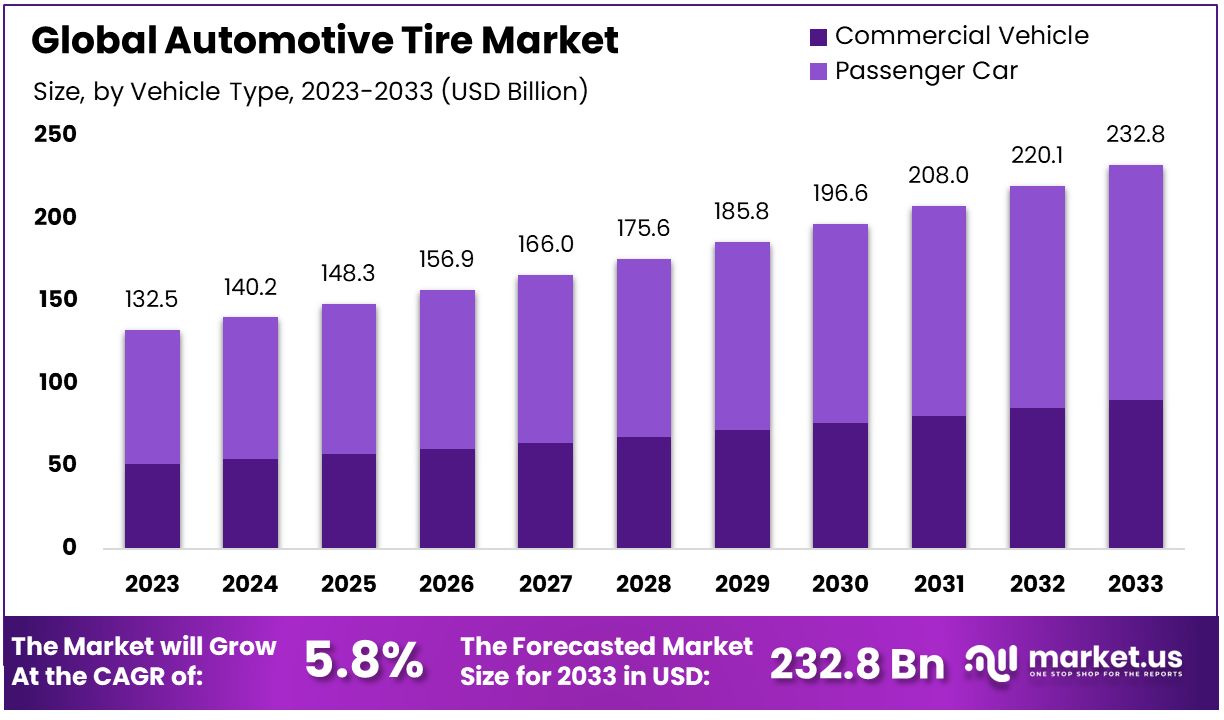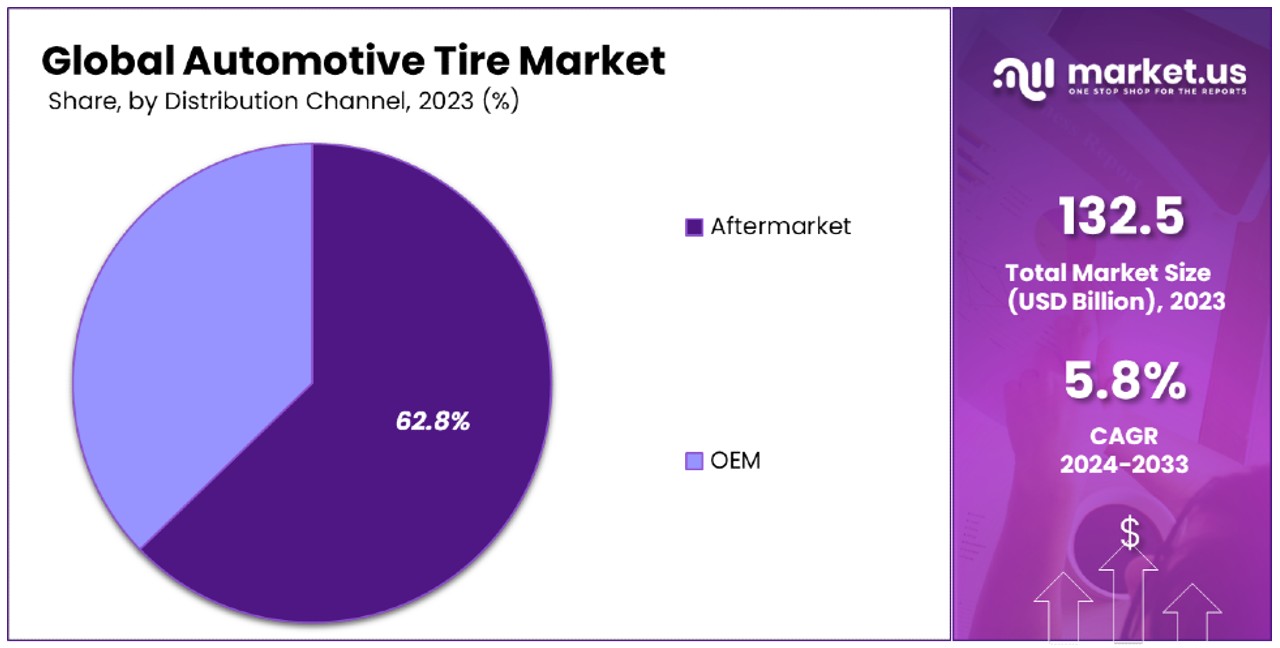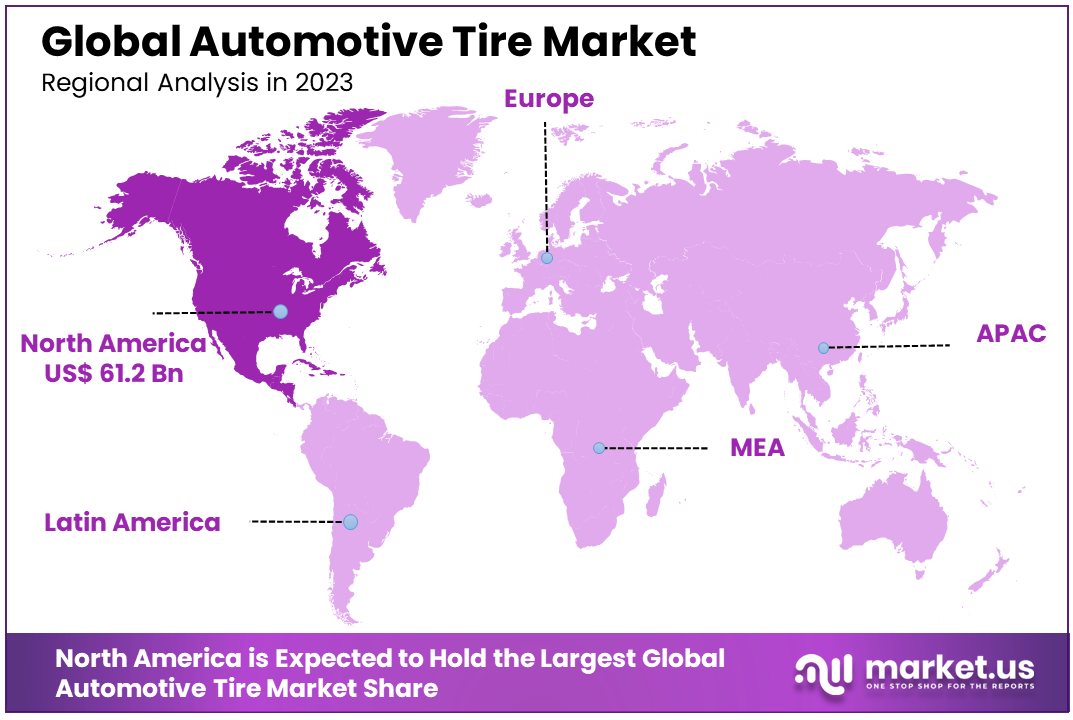Automotive Tire Market Report By Season Tire Type (Summer, Winter, All-season), By Rim Size, By Vehicle Type (Commercial Vehicle, Light Commercial, Heavy Commercial, Passenger Car), By Distribution Channel, By Region and Companies - Industry Segment Outlook, Market Assessment, Competition Scenario, Trends and Forecast 2024-2033
- Published date: Feb 2024
- Report ID: 22409
- Number of Pages: 268
- Format:
- keyboard_arrow_up
Quick Navigation
Report Overview
The Global Automotive Tire Market size is expected to be worth around USD 232.8 Billion by 2033, from USD 132.5 Billion in 2023, growing at a CAGR of 5.80% during the forecast period from 2024 to 2033.
The Automotive Tire Market refers to the industry focused on manufacturing, distributing, and selling tires for vehicles, including cars, trucks, and motorcycles. It encompasses the production of various types of tires, such as radial, bias-ply, and tubeless tires, catering to diverse vehicle models and consumer preferences.
Factors driving this market include increasing vehicle sales, technological advancements enhancing tire performance and durability, and stringent safety regulations. Key players in this market include tire manufacturers, automotive companies, and retailers.

In the Automotive Tire Market, a variety of factors underscore the sector’s growth trajectory and market dynamics, particularly in the context of U.S. vehicle ownership trends.
According to Forbes Advisor, an overwhelming majority of U.S. households (91.7%) possessed at least one vehicle in 2022, with a notable 22.1% of these households owning three or more vehicles. This high penetration rate of vehicle ownership serves as a pivotal driver for the automotive tire market, indicating a sustained demand for replacement tires and related services.
This reflects the inherent need for automotive tires but also suggest a broader trend of increasing vehicle utility and dependency among U.S. consumers. The multiplicity of vehicles per household underscores a diverse market segment that spans from economy to luxury vehicles, each with specific tire requirements in terms of performance, durability, and technology integration.
Given these insights, the automotive tire market is poised for growth, fueled by both replacement cycles and the advent of new vehicle sales. Manufacturers and retailers alike must adapt to evolving consumer preferences, including heightened expectations for eco-friendly and performance-optimized tire options.
Strategic positioning within this market necessitates a keen understanding of demographic trends, technological advancements in tire manufacturing, and the regulatory landscape influencing vehicle standards and environmental considerations.
Key Takeaways
- Market Growth Projection: The Global Automotive Tire Market is poised for significant growth, expected to reach USD 232.8 Billion by 2033 from USD 132.5 Billion in 2023, with a strong CAGR of 5.80% between 2024 and 2033.
- Segment Analysis:
- Season Tire Type: All-season tires dominate the market with a share of 55.4%, showcasing their popularity and versatility across different driving conditions.
- Rim Size: The segment of tires with rim sizes ranging between 16 inches and 18 inches holds a considerable share of 31.6%, indicating the preference for this range among consumers.
- Vehicle Type: Passenger cars emerge as the leading segment, capturing a significant market share of 61.3%, reflecting the high demand for tires in the passenger vehicle segment.
- Distribution Channel: Aftermarket distribution holds a substantial share of 62.8%, underlining the importance of aftermarket sales channels in the automotive tire market.
- Regional Analysis:
- North America: The North American region accounts for a notable portion of the market, with a share of 46.2%. This indicates a strong presence and demand for automotive tires in the region.
- Key Players: Prominent companies in the Global Automotive Tire Market include Bridgestone Corporation, Continental AG, Cooper Tire & Rubber Company, Goodyear Tire & Rubber Company, Hankook Tire Group, Michelin, MRF (Madras Rubber Factory Limited), Pirelli & C SpA, Apollo Tires, Yokohama Rubber Co. Ltd, Sumitomo Rubber Industries Ltd, and Toyo Tire Corporation.
Driving Factors
Growth in Mileage Driven Drives Market Growth
Increased economic development worldwide is leading to more vehicles on the road and longer distances traveled. This uptrend results in quicker tire wear, subsequently raising the demand for tire replacements. For instance, the United States saw vehicle miles traveled grow by over 3% in 2021.
This surge indicates a direct correlation between economic growth, vehicle usage, and the tire market’s expansion. As mileage accumulates, the need for durable and reliable tires escalates, propelling the automotive tire market forward. This factor is intricately linked with evolving consumer lifestyles and economic activities, highlighting its significant impact on market dynamics.
Consumer Preference for High-Performance Tires Fuels Market Growth
Today’s consumers exhibit a pronounced preference for high-performance tires, valuing safety, ride quality, low noise, and improved fuel economy. This shift towards premium tires is driving market growth, as customers are increasingly willing to invest in higher-quality options for enhanced driving experiences.
Such preferences are reshaping the tire market, steering manufacturers toward the production of advanced, high-value products. This trend not only reflects changing consumer expectations but also underscores the market’s potential for innovation and premiumization, further stimulating growth and diversification within the sector.
Development of New Tire Technologies Spurs Market Growth
The tire industry is witnessing significant investments in research and development, focusing on new materials and tread designs to extend tire life, reduce rolling resistance, and enhance grip under various conditions. These advancements are introducing a wave of product innovations, meeting the demand for more efficient, safer, and environmentally friendly tires.
The integration of automotive 3D printing in tire manufacturing is revolutionizing the industry, allowing for the creation of intricate tread designs and customized tire structures that enhance performance, durability, and safety.
This continuous innovation cycle not only meets current market demands but also anticipates future needs, ensuring the sector’s resilience and adaptability. The integration of new technologies in tire manufacturing is not only elevating product standards but also fostering a competitive environment that drives growth and sets new benchmarks in the automotive tire market.
Restraining Factors
Raw Material Price Volatility Restrains Market Growth
The automotive tire market faces significant challenges due to the volatility in prices of key raw materials, such as natural rubber and crude oil derivatives. These materials are essential for tire production, and their fluctuating costs directly impact manufacturers’ production expenses and profit margins.
For example, in 2021, the price of natural rubber swung widely between $1.2 and $2.5 per kilogram. Such unpredictability makes it difficult for tire manufacturers to forecast costs and set prices, potentially leading to higher retail prices for consumers and, consequently, affecting market growth as manufacturers and buyers alike navigate these financial uncertainties.
Counterfeit Products Limit Market Expansion
The presence of counterfeit and substandard tires in the market poses a significant restraint on the growth of the legitimate automotive tire industry. These counterfeit products, often made from inferior materials, fail to meet safety and performance standards, endangering consumers and undermining the reputation of established brands.
With estimates indicating that counterfeit tires account for more than 5% of the global tire trade volume, the impact is non-negligible. This not only affects consumer trust in tire products but also leads to lost sales for legitimate manufacturers, as these illegal products compete directly with genuine tires, often at lower price points.
Season Tire Type Analysis
The automotive tire market is intricately segmented by season tire type, with all-season tires dominating the landscape, holding a substantial 55.4% market share. This dominance is rooted in the versatility and convenience that all-season tires offer. They are engineered to provide balanced performance in varied driving conditions, from dry asphalt to wet roads and light snow, making them a popular choice among consumers seeking value and efficiency.
This preference is driven by the growing demand for vehicles equipped to handle diverse weather conditions without the need for tire changeover, reflecting a broader trend towards practicality and cost-effectiveness in consumer behavior.
While all-season tires lead the market, summer and winter tires remain crucial for specific regional and climatic needs. Summer tires are preferred in warmer climates for their superior grip and handling on hot roads, whereas winter tires are essential in cold regions, offering enhanced traction in snow and ice.
Each sub-segment caters to distinct driving conditions, illustrating the market’s complexity and the importance of specialized tire types for safety and performance. Despite the dominance of all-season tires, the presence and development of summer and winter tires underline the industry’s adaptability and responsiveness to global consumer demands and environmental factors.
Rim Size Analysis
In the segmentation by rim size, the 16″-18″ category emerges as the market leader with a 31.6% share, evidencing the automotive industry’s evolving design and consumer preferences towards vehicles that balance performance and aesthetics.
This rim size range is particularly favored for its compatibility with a wide array of vehicle types, from compact cars to light SUVs, offering a blend of improved handling, fuel efficiency, and visual appeal. The preference for 16″-18″ rims is reflective of the market’s shift towards more dynamic and efficient vehicle designs, accommodating consumer desires for cars that deliver both function and form.
The remaining segments, including <15″, 19″-21″, and >21″, contribute to the market’s diversity, each serving different vehicle niches and consumer tastes. Smaller rims (<15″) are typically associated with economy and city cars, prioritizing cost-effectiveness and maneuverability. On the other end, larger rims (19″-21″ and >21″) are often found on luxury vehicles, sports cars, and high-performance SUVs, where they enhance aesthetics and driving dynamics.
Although 16″-18″ rims dominate, the variety in rim sizes underscores the automotive tire market’s segmentation, catering to a broad spectrum of consumer preferences and vehicle specifications. This segmentation illustrates the industry’s nuanced understanding of consumer behavior, vehicle design trends, and the technological advancements that drive tire development and selection.
Vehicle Type Analysis
In the Automotive Tire Market, the Passenger Car segment emerges as the dominant sub-segment, holding a significant 61.3% share. This dominance is largely attributed to the escalating global demand for personal vehicles driven by increasing disposable incomes and the growing middle class, especially in emerging economies.
Passenger cars, as a category, benefit from rapid technological advancements and evolving consumer preferences towards more fuel-efficient and environmentally friendly vehicles. These trends not only fuel the demand for new tires but also for specialized tires catering to electric and hybrid vehicles, underscoring the segment’s substantial impact on the market.
Conversely, the Commercial Vehicle segment, encompassing Light Commercial and Heavy Commercial vehicles, plays a pivotal role in the global economy, facilitating the transport of goods across vast distances. While these segments command a smaller portion of the market compared to Passenger Cars, their importance cannot be understated.
The durability and performance requirements for commercial vehicle tires are significantly higher, given the heavy loads and longer distances involved. This necessitates frequent replacements and upgrades, contributing to steady market growth. Light Commercial Vehicles (LCVs) are vital for urban logistics and last-mile deliveries, particularly with the rise of e-commerce, whereas Heavy Commercial Vehicles (HCVs) are essential for industrial and large-scale transportation needs.
Distribution Channel Analysis
The Aftermarket segment leads the Distribution Channel category with a 62.8% market share, highlighting the robust demand for tire replacements and upgrades post the initial purchase. This segment’s growth is propelled by factors such as wear and tear, advancements in tire technology, and consumers’ desire for performance enhancements. The aftermarket’s dominance is further solidified by the extensive network of service centers and retailers, offering consumers a wide array of choices in terms of brands, specifications, and price points.
The OEM (Original Equipment Manufacturer) segment, although smaller in comparison, holds crucial significance in establishing the initial quality and performance standards for tires fitted on new vehicles. This segment benefits directly from the automotive industry’s growth, with every new vehicle representing a direct opportunity for tire manufacturers.
The collaboration between tire manufacturers and automotive OEMs is vital for the development of specialized tires that meet the specific performance requirements of new vehicle models, including electric and autonomous vehicles. Despite its smaller market share, the OEM segment’s role in introducing innovative tire technologies and setting industry standards is indispensable for the broader market’s evolution and expansion.

Key Market Segments
By Season Tire Type
- Summer
- Winter
- All-season
By Rim Size
- <15″
- 16″-18″
- 19″-21″
- >21″
By Vehicle Type
- Commercial Vehicle
- Light Commercial
- Heavy Commercial
- Passenger Car
By Distribution Channel
- Aftermarket
- OEM
Growth Opportunities
All-Season and Winter Tires Offer Growth Opportunity
The development of all-season and winter tires opens significant growth avenues within the Automotive Tire Market. As consumer demand shifts towards tires that can seamlessly adapt to varying weather conditions, manufacturers stand to benefit significantly, particularly in regions prone to extreme winters, such as Europe and North America.
This trend underscores a market shift towards versatility and safety, encouraging tire producers to innovate and expand their all-season and winter tire portfolios. Such developments not only cater to consumer preferences for year-round performance without the need for tire changeovers but also position manufacturers at the forefront of market trends, driving growth and market share gains in competitive regions.
Fleet Tire Management Services Offer Promising Growth Opportunity
The expansion of corporate and commercial vehicle fleets presents a lucrative opportunity for the Automotive Tire Market through outsourced tire management services. Companies like Bridgestone, Goodyear, and Michelin are already capitalizing on this trend by offering comprehensive fleet management solutions.
These services, which include tire maintenance, replacement, and performance monitoring, address the growing need for operational efficiency and cost savings among fleet operators. As fleets continue to expand globally, the demand for such specialized services is expected to rise, offering tire manufacturers and service providers a chance to diversify their offerings and tap into a steady revenue stream, further propelling market growth.
Trending Factors
Tire Sensor Technology Are Trending Factors
The focus on tire sensor technology, specifically tires embedded with pressure and tread wear sensors, is a significant trending factor in the Automotive Tire Market. This technology enables predictive maintenance, allowing drivers to monitor tire health in real-time, thereby enhancing safety and extending tire lifespan.
As vehicles become increasingly connected, the demand for smart tires is expected to grow, positioning sensor technology as a key differentiator in the market. This trend not only meets consumer demands for advanced safety features but also opens new avenues for innovation among tire manufacturers, driving the development of more sophisticated tire solutions.
Direct-to-Consumer Sales Are Trending Factors
The exploration of direct-to-consumer sales channels by tire manufacturers represents a notable trend within the Automotive Tire Market. By leveraging online platforms, manufacturers are able to offer consumers a more convenient purchasing experience, bypassing traditional retail outlets.
This shift reflects changing consumer buying behaviors, particularly a preference for online shopping. It also allows manufacturers to engage directly with their customer base, offering personalized services and promotions. As a result, direct-to-consumer sales are not just a distribution trend but a strategic move that could reshape market dynamics, enhancing customer satisfaction and loyalty.
Regional Analysis
North America Dominates with 46.2% Market Share
North America’s significant 46.2% share in the Automotive Tire Market is driven by high vehicle ownership rates, a robust automotive industry, and a strong consumer preference for premium and specialized tires. The region’s emphasis on safety standards and environmental regulations also pushes for advanced tire technologies, further bolstering market growth.

The dominance of North America is underpinned by its advanced infrastructure for vehicle usage and a high average mileage per vehicle, leading to frequent tire replacements. Additionally, the presence of leading tire manufacturers and a trend towards electric and autonomous vehicles contribute to the region’s market strength.
Looking ahead, North America’s influence in the Automotive Tire Market is expected to remain strong. Innovations in tire technology, such as smart tires with sensors, and growing environmental concerns may further drive demand for high-performance, eco-friendly tires. The region’s proactive approach to adopting new technologies suggests a continued upward trajectory in market share and influence.
- Europe: Europe holds a significant market share due to stringent safety regulations and a high demand for winter tires. The market is driven by the need for tires that can perform in diverse weather conditions, contributing to Europe’s strong position in the global market.
- Asia Pacific: This region is rapidly growing, fueled by expanding vehicle production in countries like China and India. The increasing middle-class population and urbanization are key drivers for the automotive tire market in Asia Pacific.
- Middle East & Africa: Though a smaller market compared to others, there’s steady growth driven by increasing vehicle sales and economic development in certain countries.
- Latin America: Latin America shows potential for growth with improving economic conditions and an expanding automotive sector, though it currently holds a smaller share of the global market.
Key Regions and Countries
- North America
- The US
- Canada
- Mexico
- Western Europe
- Germany
- France
- The UK
- Spain
- Italy
- Portugal
- Ireland
- Austria
- Switzerland
- Benelux
- Nordic
- Rest of Western Europe
- Eastern Europe
- Russia
- Poland
- The Czech Republic
- Greece
- Rest of Eastern Europe
- APAC
- China
- Japan
- South Korea
- India
- Australia & New Zealand
- Indonesia
- Malaysia
- Philippines
- Singapore
- Thailand
- Vietnam
- Rest of APAC
- Latin America
- Brazil
- Colombia
- Chile
- Argentina
- Costa Rica
- Rest of Latin America
- Middle East & Africa
- Algeria
- Egypt
- Israel
- Kuwait
- Nigeria
- Saudi Arabia
- South Africa
- Turkey
- United Arab Emirates
- Rest of MEA
Key Players Analysis
In the Automotive Tire Market, a select group of companies stands out for their impact, strategic positioning, and influence. Bridgestone Corporation, Continental AG, and Michelin are at the forefront, leveraging their extensive global networks, advanced R&D capabilities, and wide product ranges to meet diverse consumer needs.
These leaders are complemented by other significant players like Goodyear Tire & Rubber Company and Pirelli & C SpA, who also contribute to setting industry standards through innovation and sustainability efforts.
Companies such as Hankook Tire Group, Cooper Tire & Rubber Company, and Yokohama Rubber Co. Ltd, while smaller in comparison, have carved out strong niches through specialized products and strategic market focus, enhancing the competitive dynamics.
Emerging players like Apollo Tires and MRF (Madras Rubber Factory Limited) are noteworthy for their rapid growth in emerging markets, leveraging local advantages and cost efficiencies to challenge established entities. Sumitomo Rubber Industries Ltd and Toyo Tire Corporation further enrich the market with their unique technologies and focus on eco-friendly solutions, underlining the industry’s shift towards sustainability and efficiency.
Market Key Players
- B.V.Bridgestone Corporation
- Continental AG
- Cooper Tire & Rubber Company
- Goodyear Tire & Rubber Company
- Hankook Tire Group
- Michelin
- MRF (Madras Rubber Factory Limited)
- Pirelli & C SpA
- Apollo Tires
- Yokohama Rubber Co. Ltd
- Sumitomo Rubber Industries Ltd
- Toyo Tire Corporation
Recent Developments
- Feb 2024, AutoNation, a national car retailer, has announced plans to expand its mobile service and parts business following its acquisition of RepairSmith Inc. for $190 million. This acquisition, which was completed last year, aims to align RepairSmith with AutoNation’s standalone used-vehicle-only AutoNation business.
- Feb 2024, Sentury Tire USA has recently launched the Bandit light truck tire line under its Delinte brand. This new tire line is designed for SUVs, CUVs, and light trucks, and it includes five products that cover a range of applications.
- June 2023, Continental, a leading tire manufacturer, is actively working to increase the sustainability of its products. The UltraContact NXT tire, for example, contains up to 65% renewable, recycled, and mass balance certified materials, with renewable materials accounting for up to 32% and recycled materials up to 5%
Report Scope
Report Features Description Market Value (2023) USD 132.5 Billion Forecast Revenue (2033) USD 232.8 Billion CAGR (2024-2033) 5.80% Base Year for Estimation 2023 Historic Period 2018-2023 Forecast Period 2024-2033 Report Coverage Revenue Forecast, Market Dynamics, Competitive Landscape, Recent Developments Segments Covered By Season Tire Type (Summer, Winter, All-season), By Rim Size (<15″, 16″-18″, 19″-21″, >21″), By Vehicle Type (Commercial Vehicle, Light Commercial, Heavy Commercial, Passenger Car), By Distribution Channel (Aftermarket, OEM) Regional Analysis North America – The US, Canada, & Mexico; Western Europe – Germany, France, The UK, Spain, Italy, Portugal, Ireland, Austria, Switzerland, Benelux, Nordic, & Rest of Western Europe; Eastern Europe – Russia, Poland, The Czech Republic, Greece, & Rest of Eastern Europe; APAC – China, Japan, South Korea, India, Australia & New Zealand, Indonesia, Malaysia, Philippines, Singapore, Thailand, Vietnam, & Rest of APAC; Latin America – Brazil, Colombia, Chile, Argentina, Costa Rica, & Rest of Latin America; Middle East & Africa – Algeria, Egypt, Israel, Kuwait, Nigeria, Saudi Arabia, South Africa, Turkey, United Arab Emirates, & Rest of MEA Competitive Landscape Bridgestone Corporation, Continental AG, Cooper Tire & Rubber Company, Goodyear Tire & Rubber Company, Hankook Tire Group, Michelin, MRF (Madras Rubber Factory Limited), Pirelli & C SpA, Apollo Tires, Yokohama Rubber Co. Ltd, Sumitomo Rubber Industries Ltd, Toyo Tire Corporation Customization Scope Customization for segments, region/country-level will be provided. Moreover, additional customization can be done based on the requirements. Purchase Options We have three licenses to opt for: Single User License, Multi-User License (Up to 5 Users), Corporate Use License (Unlimited User and Printable PDF) Frequently Asked Questions (FAQ)
What is the projected market size of the Global Automotive Tire Market?The Global Automotive Tire Market is expected to reach around USD 232.8 Billion by 2033, growing from USD 132.5 Billion in 2023, at a CAGR of 5.80%.
What are the driving factors behind the growth of the Automotive Tire Market?Factors such as increasing vehicle sales, technological advancements enhancing tire performance, and stringent safety regulations are driving market growth.
Why are all-season tires dominant in the Automotive Tire Market?All-season tires hold a substantial market share of 55.4% due to their versatility and suitability for various driving conditions, offering balanced performance across different weather scenarios.
What rim size category leads the Automotive Tire Market?The 16"-18" rim size category holds the largest market share at 31.6%, reflecting consumer preferences for a balance of performance and aesthetics in vehicle design.

- Market Growth Projection: The Global Automotive Tire Market is poised for significant growth, expected to reach USD 232.8 Billion by 2033 from USD 132.5 Billion in 2023, with a strong CAGR of 5.80% between 2024 and 2033.
- Hankook Co. Ltd.
- Continental Group
- Michelin Group
- Cooper & Rubber Company
- Goodyear & Rubber Company
- Sumitomo Rubber Industries Ltd.
- The Bridgestone Corp.
- Yokohama Rubber Co. Ltd.
- Apollo Tires
- Other Key Players
- settingsSettings
Our Clients
| Single User $4,599 $3,499 USD / per unit save 24% | Multi User $5,999 $4,299 USD / per unit save 28% | Corporate User $7,299 $4,999 USD / per unit save 32% | |
|---|---|---|---|
| e-Access | |||
| Report Library Access | |||
| Data Set (Excel) | |||
| Company Profile Library Access | |||
| Interactive Dashboard | |||
| Free Custumization | No | up to 10 hrs work | up to 30 hrs work |
| Accessibility | 1 User | 2-5 User | Unlimited |
| Analyst Support | up to 20 hrs | up to 40 hrs | up to 50 hrs |
| Benefit | Up to 20% off on next purchase | Up to 25% off on next purchase | Up to 30% off on next purchase |
| Buy Now ($ 3,499) | Buy Now ($ 4,299) | Buy Now ($ 4,999) |












